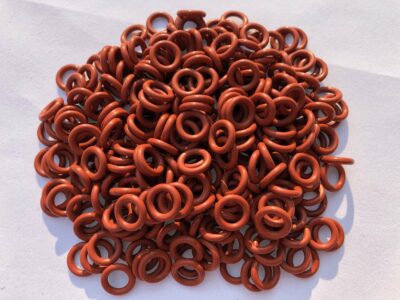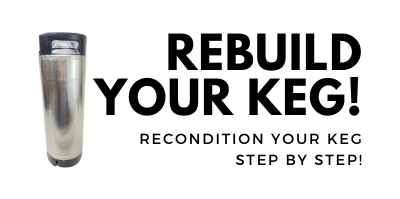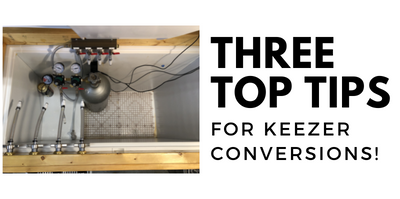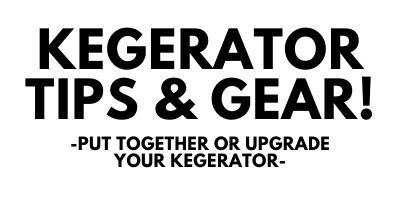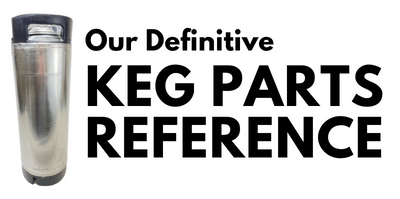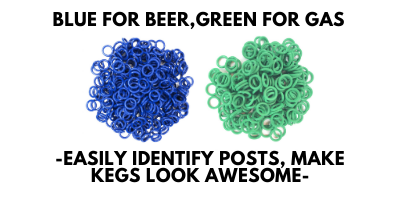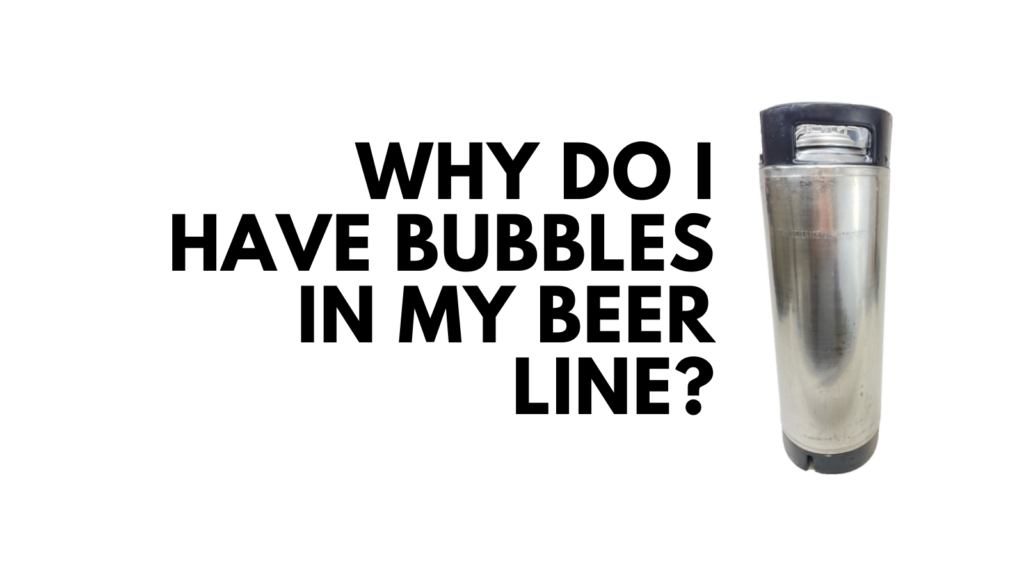
Diagnosing and Fixing Kegerator Foam Problems
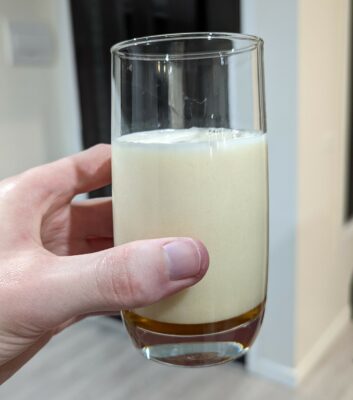 Thanks to u/Procrastinator548 on Reddit for this photo
Thanks to u/Procrastinator548 on Reddit for this photo
Got Bubbles?
Bubbles in your beer line can point to a several potential problems. These problems can lead to small bubbles… foam or larger CO2 bubbles breaking out of solution. These issues can occur at different points in your kegerator. The point at which they occur and specific behaviors can help us to track down the problem.
An Unbalanced System
First, start with a balanced system. You need the right combination of temperature, pressure and resistance to serve a proper pint of beer.
This will be a recurring theme throughout this article. Balancing your system is an important baseline. Most, but not all, of the troubleshooting steps outlined here revolve around diagnosing different versions of an unbalanced system.
See: Step by Step: Balancing Your Kegerator Draft System
Another Tool: Flow Control
As detailed in my step by step on balancing your kegerator temperature, pressure and resistance are the key factors when it comes to dialing in kegerator pours. Before I move on to diagnosing specific issues, I wanted to also mention flow control devices as an option for helping to easily balance your system without the use of long lengths of tubing.
Flow control devices feature a built in flow compensator that allows you to adjust the resistance your faucet/line/device is exerting. That means less tubing and potentially less foaming and wasted beer. The compensation feature also makes it easier to serve higher carbonation beers as you can set the faucet to provide resistance to offset the increased pressure needed to store and serve these beers at higher pressures. Instead of replacing your beer line with ever increasing lengths of tubing, you simply turn a knob to increase resistance.
See the end of this article for flow control options
First Foamy Pint
Temperature is fundamental when it comes to serving beer. It will appear throughout this resource.
The first foamy pint issue is a common problem and easy to diagnose. With this issue you’ll get a… first foamy pint and then subsequent beers poured soon after will be great.
This is caused by warm beer lines or other warm equipment in the path of your beer. The beer that’s sitting in your beer lines is warming up. Warmer beer does not hold CO2 as readily. Your warm-ish beer hits the faucet and whammo… you get foam for the first couple pours. The problem clears up because your lines, shanks and faucets cool down after you’ve run enough beer through the lines. I’ve seen people discard half a pitcher of foamy beer before things clear up. Lost beer isn’t good.
The solution revolves around getting and keeping your lines chilled as much as possible
- Use a recirculating fan to stamp out warm spots. I have a freezer based kegerator/keezer and this has resolved the first foamy pint issue for my kegerator. See: Kegerator Beer Line Temperatures & Reducing Foam with a Recirculating Fan
- If your kegerator has a draft tower, consider getting a tower cooler. These are fan setups that are designed to blow cold are into your tower. Cooling the tubing and tower down. Search “Beer Tower Cooler” on Amazon to look for some options.
- Neoprene Wraps are available that further insulate your tower. These should help reduce foam and help save on energy. Search “kegerator tower insulation” on Amazon to look for some options
- Use longer shanks. A longer shank means… a colder faucet. A colder faucet means less foam. Credit for this tip goes to Tom Schmidlin.
- For longer runs that go outside your kegerator, considering a recirculating coolant line. This line would run alongside your beer lines circulating cold liquid. Commercial establishments use recirculating glycol lines for this purpose. Those are generally very expensive. You could build a similar budget setup by recirculating water using a utility pump. You’ll also want to insulate those lines. Search “propylene glycol” on Amazon
- Brass Draft Beer Shank Cold Block – These thread on to your standard shank to let you run glycol or water lines through them. Cold shanks and faucets mean less foam. Search eBay for “brass cold block”
- Nukatap Faucets – One of the specific design goals of this faucet. Reduce thermal mass to reduce foaming.
Over-Carbonated Beer
 Thanks to u/Procrastinator548 on Reddit for this photo
Thanks to u/Procrastinator548 on Reddit for this photo
Your beer has been over carbonated because of an unbalanced system or over zealous force carbonation.
A sign that this could be the problem is that multiple pints served one after another pour foamy.
See: Fix Over-Carbonated Beers with a Spunding Valve
Beer Line Too Warm
Heat rises. This causes the top of your kegerator to be warmer than the center and bottom of your kegerator. In all likelihood your faucets, shanks and some tubing are in the warmer part of your kegerator. This causes CO2 to come out of solution and causes foam.
A sure sign that this is the problem is that the first pint pours foamy and subsequent pints poured soon after pour correctly. The problem comes back again after a longer period of time as things warm up again.
A solution to this is to add a recirculating fan to even out temps.
See: Kegerator Beer Line Temperatures & Reducing Foam with a Recirculating Fan
Pressure is Too Low
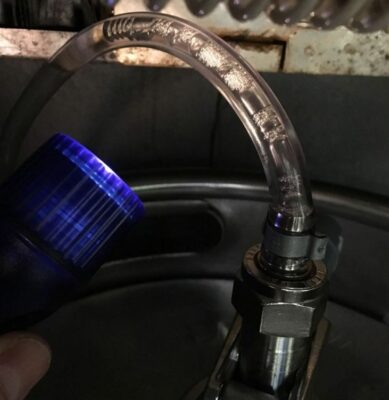 Photo via the BA’s Great Resource, Demystifying Dispense Gas
Photo via the BA’s Great Resource, Demystifying Dispense Gas
Another problem related to improper balancing. If your serving pressure is too low for the resistance of your system you can get foaming or bubbles.
A sign that this could be the problem is foam starts occurring at some point after leaving your keg. There is a length of tubing that looks good and then later you can visibly see foam in the tubing. This can be while you’re serving beer or co2 can breakout causing visible pockets in the beer line.
See: Step by Step: Balancing Your Kegerator Draft System
Pressure is Too High
If pressure is set too high you’ll get foaming at the faucet. It’s also quite likely that your beer will also be over-carbonated.
A sign that this could be the problem is that beer looks good in tubing and you get excessive foam at the faucet. This would typically be accompanied by the beer serving too quickly.
See:
Beer Line Too Short
If pressure is set too high you’ll get foaming at the faucet. It’s also quite likely that your beer will also be over-carbonated.
A sign that this could be the problem is that beer looks good in tubing and you get excessive foam at the faucet. This would typically be accompanied by the beer serving too quickly.
See:
Diagnosing Between: Pressure Too High vs Beer Line Too Short
These issues can present themselves the same way. Fast pours and excessive foam that starts at the faucet. One troubleshooting step you can take is decreasing pressure, venting keg head space and serving a pint. If the pint is too carbonated and excessively foamy, it’s probably a pressure issue. If the beer serves okay, it’s probably a beer line length issue.
Slow Flow, Cavitating Bubble When Serving
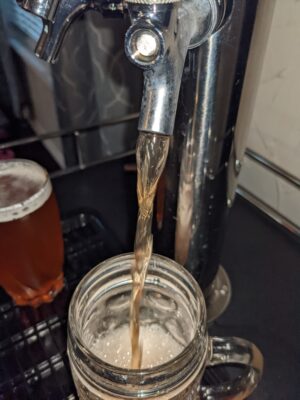 Thanks to u/lolwatokay on r/homebrewing for this photo!
Thanks to u/lolwatokay on r/homebrewing for this photo!
This problem presents itself at the faucet with cavitation at the tap. An air bubble is trapped within the beer while serving. This is generally a flow rate issue, caused by incorrect pressure or resistance, a blockage or potentially a dirty faucet that’s gumming up the works. If you’re certain your system is correctly balanced, clean the line and faucet and take apart everything on the liquid side to ensure it’s properly assembled.
- Step by Step: Balancing Your Kegerator Draft System
- Build A Recirculating Draft Line Cleaning Pump
- Mark II Keg and Carboy Cleaner Draft Line Cleaning Pump Conversion
- Building a Simple Ball Lock Draft Line Flushing Setup
Large CO2 Bubbles in Beer Line
Continual, larger CO2 bubbles in your beer line while serving.
A bad gas dip tube o-ring or a gas post o-ring is allowing head space CO2, in the case of the dip tube o-ring, or atmospheric air, in the case of the post o-ring, into the line at the time of vending.
Replace both post and dip tube o-rings and re-assemble everything on the gas side to make sure everything looks good and is installed and seated properly.
See:
- Bulk, Food Grade Replacement O-Rings
- Rebuilding & Reconditioning Homebrew Kegs!
- Step by Step: Finding and Fixing Keg CO2 Leaks
Obstruction
An obstruction can cause turbulence which results in foaming issues. The obstruction could be at an point in your setup. Dip tube, post/poppet, beer line, shank or faucet. The most likely culprit for this would be hop or other trub material.
What Else?
Diagnosing these sorts of issues can be frustrating. Have you run into a scenario that isn’t outlined here? Got a comment or tip related to one of these conditions? Got a correction? Do you have a photo that nicely illustrates one of these issues that you can share to help your fellow homebrewer?
Let me know!
- Email Me
- Use my Submit a Tip Form
- Leave a comment on this post
Flow Control Faucets and Devices
Flow control devices feature a built in flow compensator that allows you to adjust the resistance your faucet/line/device is exerting. That means less tubing and potentially less foaming and wasted beer. The compensation feature also makes it easier to serve higher carbonation beers as you can set the faucet to provide resistance to offset the increased pressure needed to store and serve these beers at higher pressures. Instead of replacing your beer line with ever increasing lengths of tubing, you simply turn a knob to increase resistance.
Intertap Stainless Steel Forward Sealing with Flow Control
Intertap forward sealing faucets have a unique modular, threaded spout design which can fit a variety of different attachments including a growler filler, stout spout and ball lock post. Check out my Hands on Review of these great faucets.
Intertap+Flow Control have been largely discontinued. The great news, at least as of this posting, is that Nukatap+Flow Control are generally available…
NUKATAP Stainless Steel Forward Sealing with Flow Control
These are Kegland’s follow up to their great Intertap lineup. They work with all Intertap accessories and sport a number of improvements. Check out our Hands on Review of these great faucets.
- Nukatap Stainless Flow Control Faucet at William’s Brewing
- NukaTap Stainless Steel Beer Faucet (With Flow Control) D1584 at MoreBeer
- NUKATAP Forward Sealing Flow Control Faucet – Stainless Steel at Keg Outlet
Perlick 650SS
- via MoreBeer
- via Keg Connection
- via Adventures in Homebrewing
- via Austin Homebrew Supply
- via Keg Outlet
- via Amazon
More Flow Control Faucets
- CMB Flow Control Event or Party Faucet – the only handheld faucet I’m aware of that has flow control
- Search flow control beer faucet at Amazon – offerings vary
Flow Control Devices
- KegLand Duotight 8mm Flow Control Beer Ball Lock – Allows DuoTight and EVABarrier users to easily dial in resistance without long lengths of tubing.
- KegLand Stainless Flow Control Ball Lock Threaded – similar idea to flow control faucets. These take the place of your standard ball lock liquid QD and feature a dial to let you change resistance.
- CMB Inline Flow Control – installs inline on the liquid side of your kegerator
- Flow Control Shank Adapter – installs at the shank to convert faucets to flow control
Related Resources – Foam Control & Kegerator Balancing
- What Does a Flow Control Faucet Do?
- Step by Step Balancing Your Kegerator Draft System
- Kegerator Beer Line Temperatures & Reducing Foam with a Recirculating Fan
Rebuild Your Kegs!
Related: Three Top Tips for Keezer Conversions!
Our Draft Resource Page!
Replacement Keg Parts Reference
Color Code Your Posts!
More Homebrew Finds!
- Last 50 Finds!
- Top Deals – a curated list of the best deals
- Homebrew Reviews – one of the largest libraries of homebrew reviews in existence!
- Our Top Posts – tips, how-tos, resources posts and more
- Let’s be Friends!
Recent Deals!
10 Most Recent Homebrew Resource Posts & How-To’s!
Also: Kegerator Tips & Gear | Keg Repair Part #s | Recent Keg Finds
Our Top Draft Resources!
Check our our Top Draft Related Resources- Commentary: Pin Lock Keg Pricing and Availability
- Check Your CO2 Regulator for Leaks!
- How to get a keg ready for first use? New Keg Cleaning and Prep
- Portable Draft Beer Serving Options!
- Pin Lock Keg Pricing and Availability
- The Most Difficult Spot to Check for CO2 Leaks
- Keg O-Ring Materials Selection! – EPDM, Silicone and Buna-N?
- Why Do I Have Bubbles in My Beer Line? Diagnosing and Fixing Kegerator Foam Problems
- Five Benefits of Using Corny Kegs As Fermenters
- Rebuilding & Reconditioning Homebrew Kegs!
- Food Safe Replacement Keg O-Rings in Bulk
- Hands on Review: Kegland DuoTight Fittings & EVABarrier Tubing!
- Why Won’t My Beer Carbonate? Fixing Draft Beer Carbonation Problems
- What Does a Flow Control Faucet Do?
- Upgrade Your Kegerator – 6 Improvements!
- Serve Homebrew on Any Kegerator & Convert Commercial Kegerator to Homebrew
- Tips and Gear for Growler Filling
- What’s the Difference Between Ball Lock Kegs and Pin Lock Kegs?
- Checking for Draft System CO2 Leaks – Using The Pressure Gauge Method
- Tip: Consider Oetiker Stepless Clamps for Kegerator Gas and Beer Lines
- Hands On Review: Inkbird ITC-308 Dual Stage Temperature Controller +WiFi Version
- Universal Poppets Tips and Tricks!
- Convert Your Mark II Keg & Carboy Washer to a Recirculating Draft Line Cleaning Pump!
- Step by Step: Finding and Fixing Keg CO2 Leaks
- Kegerator Temperature Probe Placement – To Immerse or Not To Immerse? – three tests to determine optimal pla…
- Kegerator Beer Line Temperatures & Reducing Foam with a Recirculating Fan
- Kegging CO2 Use Estimations and Calculations
- Balancing Your Kegerator Draft System
- Building a Simple Ball Lock Draft Line Flushing Setup
- Build a Recirculating Draft Line Cleaning Pump
- Home Brew Keg Roundup – New & Used, 5 and 2.5 Gallon & More!
- Damp Kegerator? Fix Kegerator Condensation
- Homebrew Temp Controller Roundup! – Kegerator and Fermentation – concepts, applications and models
- Bulk Keg Orings and Keg Parts Reference
This post may contain affiliate links. We may make a commission when you use our links. This will never cost you extra. Thank you for supporting Homebrew Finds!
greatdealsThis is a Top Post! See: All Top Posts
Make sure the components you use are compatible and rated for your intended application. Contact manufacturer with questions about suitability or a specific application. Always read and follow manufacturer directions. tag:lnksfxd toppost:linebubbles rs:8 tag:tpr
